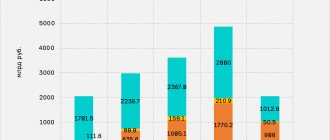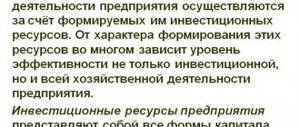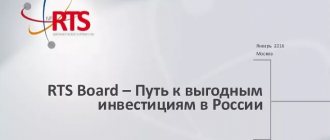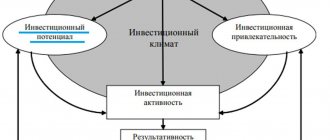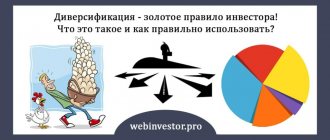Over the 25 years of Russia’s recent economic history, the investment sector of the economy has provided a lot of opportunities to make money on various markets, types of instruments, and assets of promising types of businesses. At the very beginning, these were checking investment funds, various savings funds, more, however, similar to financial pyramids (such as MMM, Khoper Invest and other “celebrities”)
Another stage was (especially in the early 2000s) a great demand for shares of leading companies (national treasures such as Gazprom), the first collective investment funds (MUIFs and OFBUs) appeared and, of course, the real estate market began to quickly gain popularity.
After the crises of 2008-2009 and the current crisis of the Russian economic model, investors' desire to invest in clearly overvalued assets of the Russian stock market and even more so in real estate has diminished. Investment methods such as foreign real estate (especially commercial) and shares of companies that are in one way or another connected with promising areas of economic development have become popular.
In this regard, companies that operate in the market of innovation and scientific research are of particular interest. With all its features, this market around the world is in greatest demand among investors all over the planet. It is enough to give such vivid examples as Google, Space-X, Facebook, Alibaba, Uber to understand what opportunities there are for investment in the high-tech market today.
This article will talk about how to make money in the venture innovation sector market, what ways you can invest and what you need to know about it to achieve success.
Definition and essence of the investment market
As you know, the investment market is usually called a system based on free competition and partnerships between entities engaged in investment activities. As a rule, from a practical point of view, it is customary to put an identity mark between the investment and stock markets. This is primarily due to their main investment instruments - securities, which can be used as individual deposits and institutional . More often than not, it is the actual investment in the form of capital investment that receives the greatest number of benefits.
If we consider the investment market from a global point of view, then we will conclude that it is nothing more than a place in which transactions for the purchase and sale of all kinds of goods and services necessary to ensure the investment process as such are carried out. Due to the diversity of participants, the exchange is considered a complex system , the circulation of which uses the tools necessary to ensure and maintain demand among the actors.
Statistics on the innovation market
The market for new technologies in Russia is being formed based on those circumstances when entrepreneurs are not able to create innovations on their own, but are trying to obtain them from past results of research work from the times of the USSR. Because of this, the market in this area is formed in a specific way.
View this post on Instagram
“Man at the intersection of trends in the technological revolution” is the theme of the @openinnovations forum, which opened today in Moscow. In his speech at the forum, Prime Minister @damedvedev spoke about his vision of new trends related to the widespread introduction of innovation. The full text of the speech is on the government website www.government.ru The @openinnovations forum, which opened in Moscow today, focuses on humanity in the center of the technological revolution. In his address to event participants, Prime Minister @damedvedev spoke about his view of new trends in all-around innovation
A post shared by Government of Russia (@government_rf) on Oct 28, 2015 at 5:15am PDT
In our country, the innovation market is characterized by:
- semi-closed entry and exit barriers;
- low investment activity;
- weak economic growth.
To develop know-how, Russia needs to invest billions of dollars. Due to the tense macroeconomic situation, the development of many projects was suspended. This area is completely dependent on government support and is now experiencing severe financial starvation.
In developed countries, investing in innovation is embedded at the level of the economic structure. In modern Russia, attempts have been made to copy developed Western methods to the Russian economy, however, the practical application of such a strategy has shown that it is ineffective.
In the innovation market, since 1992, the Russian Federation has lagged behind developed countries in all sectors. But even the purchase of the latest developments from other countries is a rather complex and time-consuming process. As soon as manufacturing enterprises try to purchase, for example, modern equipment, they directly or indirectly fall under various restrictions on their sale.
After unsuccessful attempts to adopt foreign experience, the government understands the development of innovation as a return to the experience of the Soviet Union, when scientific and technological development was centralized, institutes, academies of sciences and universities were created, which were funded by the state. But the experience of the USSR is seen more as instructive than as an example to follow.
Main functions
The subject of our conversation plays an important role in the system of any state. This is due to the fact that it provides the implementation of the following functions:
- finding the most optimal directions for investment of capital;
- mobilization of temporarily free capital from various sources;
- finding conditions to minimize risks ;
- activation of economic processes by increasing the turnover of funds;
- distribution of capital so that it can reach the end consumer;
- setting market prices for investment instruments taking into account market conditions;
- performing an intermediary function between clients.
Enterprise investment policy: eight main stages
The investment activity of the enterprise is subordinated to the long-term goals of its development. Therefore, it must be carried out in accordance with the developed investment policy. Such a policy is formed as part of the overall financial strategy of the enterprise as its independent block. This block is pivotal, as it is aimed at implementing not only the financial, but also the corporate strategy of the enterprise - incomplete or ineffective implementation of the enterprise’s investment policy jeopardizes the implementation of its entire strategic set.
Investment policy is part of the overall financial strategy of an enterprise. It consists in choosing and implementing the most effective forms of real and financial investment in order to ensure high rates of its development and a constant increase in its market value.
The development of a general investment policy for an enterprise covers the following main stages:
- Analysis of the investment activity of the enterprise in the previous period
- Research and consideration of the conditions of the external investment environment and investment market conditions
- Taking into account the strategic development goals of the enterprise, ensured by its upcoming investment activities
- Justification of the type of investment policy of an enterprise for the purposes of investing capital, taking into account risk preferences
- Formation of the enterprise’s investment policy in the main areas of investment
- Formation of an enterprise’s investment policy by industry
- Formation of an enterprise's investment policy on a regional basis
- Interrelation of the main directions of the enterprise’s investment policy
1. Analysis of the investment activity of the enterprise in the previous period
The main purpose of such analysis is a comprehensive assessment of the internal investment potential of the enterprise and the effectiveness of its investment activities.
- At the first stage of the analysis, the total volume of investment activity of the enterprise is studied at individual stages of the period under review, the rate of dynamics of this indicator in comparison with the rate of development of the total amount of operating assets, equity capital and product sales volume.
- At the second stage of the analysis, the relationship between individual areas of the enterprise’s investment activity—the volume of its real and financial investment—is examined. The dynamics of these investment volumes are compared with each other, the share of each investment area is determined, and their role in the development of the enterprise is examined.
- At the third stage of the analysis, the level of diversification of the enterprise’s investment activities is considered in industry and regional contexts, determined by the degree of compliance of this level with the industry and regional policy for the development of its operational activities.
- At the fourth stage of the analysis, the effectiveness of the enterprise’s investment activity in the period under review is determined. For this purpose, a system of indicators of profitability of investment activities as a whole is used, including by areas of investment; these indicators are compared with return on assets and equity; indicators of turnover of investment resources are considered; using factor analysis methods, the degree of influence of individual indicators of the effectiveness of investment activity on the growth of the market value of the enterprise is established.
2. Research and consideration of the conditions of the external investment environment and investment market conditions
In the process of such research, the following are studied:
- legal conditions for investment activity in general and in the context of individual forms of investment (“investment climate”);
- the current state of the investment market and its determining factors are analyzed;
- the nearest conditions of the investment market are predicted in the context of its individual segments related to the activities of the enterprise.
In the process of studying the conditions of the investment market, it should be taken into account that it consists not only of certain types of financial market (securities market, market of monetary investment instruments, market of gold and other precious metals), but also of certain types of market for real investment objects.
The study of the external investment environment and investment market conditions is carried out using the methods of strategic, technical and fundamental analysis.
3. Taking into account the strategic development goals of the enterprise, ensured by its upcoming investment activities
The nature of the goals of the corporate and financial strategies of an enterprise that require investment support should be considered as a system of strategic goals of investment activities, which should be reflected in its investment policy. It should be borne in mind that the objective factor determining the direction of an enterprise’s investment policy is the stage of the life cycle in which the enterprise is located.
4. Justification of the type of investment policy for the purposes of investing financial resources, taking into account risk preferences
At this stage of the formation of the general investment policy of the enterprise, the target function of its investment activity is determined by the criterion of the ratio of the level of its profitability and risk. This criterion is based on the general philosophy of financial management of an enterprise, which is part of its strategic set.
In the theory of financial management, there are usually three types of investment policy of an enterprise based on the criterion of investor’s risk preferences - conservative, moderate and aggressive:
- Conservative investment policy is aimed at minimizing investment risk as a priority goal.
- A moderate (compromise) investment policy is aimed at selecting investment objects for which the level of current profitability, capital growth rate and risk level are most close to the market average.
- An aggressive investment policy is aimed at maximizing current income from capital investments in the near term.
The choice of a specific type of investment policy of an enterprise for the purpose of investing capital, taking into account the risk preferences of its owners and managers, is carried out taking into account the following factors:
- financial philosophy of the enterprise;
- the chosen type of corporate and financial strategy of the enterprise;
- the presence of the necessary choice in the investment market of relevant real investment projects and financial investment instruments;
- financial condition of the enterprise.
5. Formation of the enterprise's investment policy in the main areas of investment
At this stage of the formation of the enterprise's investment policy, the ratio of the volumes of real and financial investment in the process of its upcoming investment activities is determined. Optimization of this ratio is based on taking into account a number of objective external and internal factors, the main of which are:
- Functional orientation of the enterprise.
- Stage of the enterprise life cycle.
- Enterprise size.
- The nature of strategic changes in operating activities.
- Predicted interest rate in the financial market.
- Projected inflation rate.
The functional orientation of an enterprise's activities significantly influences the ratio of areas of real and financial investment.
Enterprises - institutional investors carry out their investment activities primarily in the securities market. Consequently, the main direction of their long-term investment activity will be investing in stocks, bonds, savings certificates and other stock instruments. The share of real investment in such enterprises can fluctuate only within the limits permitted by law for each of these groups of investors. At the same time, for enterprises engaged in production activities, the primary direction of investment will be real investments (in the form of capital investments, purchase of privatization objects, etc.). It is this direction of investment that allows such enterprises to develop at the highest rates, develop new types of products, and penetrate new product and regional markets.
Financial investments of such enterprises are associated, as a rule, with short-term investments of temporarily free funds or are made with the aim of establishing control (influence) over the activities of individual companies (partner enterprises, competitor enterprises, etc.).
The stage of an enterprise's life cycle determines the needs and possibilities for implementing various areas of investment. Thus, at the stages of “childhood” and “adolescence”, the overwhelming share of investments made by an enterprise is in real form; at the “early maturity” stage, this direction of investment also predominates; Only at the stage of “final maturity” can enterprises afford a significant expansion of the share of financial investments.
The size of the enterprise influences the ratio of directions of real and financial investment indirectly through the possible volume of formation of investment resources. Small and medium-sized enterprises, whose free access to borrowed financial resources is limited, have certain difficulties in forming a “critical mass of investments” that ensures the profitable development of operating activities. In this regard, the investment activity of small and medium-sized manufacturing enterprises is concentrated primarily on real investment, because they lack the appropriate resources to make financial investments. At the same time, large enterprises have a higher level of financial flexibility (access to external sources of financing), which gives them the opportunity to make financial investments on a larger scale.
The nature of strategic changes in operating activities determines the different cyclicality of the formation and use of investment resources. Modern literature identifies two fundamental characteristics of strategic changes in the operating activities of an enterprise - gradual and intermittent changes. Gradual strategic changes are characterized by the internal logic of the dynamics of operating activities and are associated with relatively insignificant volumes of its increase in the context of individual intervals of the strategic period. Intermittent strategic changes are characterized by significant deviations in the volume of operating activities from the traditional growth vector and are carried out spasmodically.
With gradual strategic changes in operating activities, the investment resources generated by the enterprise are consumed, as a rule, within each interval of the strategic period for the needs of real investment. Under these conditions, financial investment is short-term in nature, using temporarily free investment resources and is carried out in small volumes. With intermittent strategic changes in operating activities, enterprises accumulate a fairly significant amount of temporarily unused investment resources, which can be used in the process of financial investment - both short-term and long-term.
The predicted interest rate in the financial market influences the ratio of the directions of real and financial investment of the enterprise through the mechanism for forming the rate of net investment profit. In real investing, an increase in the interest rate causes a corresponding decrease in the rate of net investment profit, because all other things being equal, increases the cost of attracted investment resources. In financial investing, the opposite trend is observed - with an increase in interest rates, the rate of net investment profit on most financial instruments increases.
The predicted rate of inflation affects the ratio of the directions of real and financial investment of the enterprise. This is due to different levels of protection of investment objects from the effects of inflation. Real investments have a high level of protection from inflation, since prices for real investment objects usually increase in proportion to the rate of inflation. At the same time, the level of protection against inflation of most financial investment instruments is very weak - in the process of inflation, not only the amount of expected investment profit depreciates, but also the value of the investment instruments themselves, subject to subsequent repayment. Accordingly, the projected increase in inflation rates will cause an increase in the share of real investment, while the projected decrease in inflation rates will cause an increase in the financial investment of the enterprise.
Taking into account these factors, in the process of forming investment policy, the ratio of various areas of investment is differentiated according to individual intervals of the upcoming period.
6. Formation of the enterprise’s investment policy by industry
Determining the sectoral focus of investment activity is the most difficult task in developing investment policy. It requires a consistent approach to forecasting investment activity in connection with the overall corporate development strategy of the enterprise.
At the first stage, the feasibility of industry concentration or diversification of investment activities is examined. As a rule, the initial stages of an enterprise's activity are associated with its concentration on one industry that is most familiar to investors. A review of Western practice shows that many of the most successful investors have achieved high levels of wealth using a concentration strategy, i.e. without going beyond single-industry activities. Particularly striking examples are provided by the production of certain types of high-tech products (computer equipment, computer programs, etc.) or products that satisfy the new needs of a wide range of consumers. At the same time, it should be noted that among investors using this strategy, the largest number of bankruptcies is observed. This is because concentration comes with a higher level of investment risk than many investors can afford.
The industry concentration strategy can be used only at the first three stages of the enterprise life cycle, because under favorable circumstances, it can ensure the highest rates of industrial development or increase in capital. At subsequent stages of the enterprise's life cycle, as the needs for products (goods, services) of the main contingent of consumers are satisfied, it should be replaced by a strategy of industry diversification of investment activities.
At the second stage, the feasibility of various forms of sectoral diversification of investment activity within a certain group of industries is examined. Such groups can be branches of agricultural production, food industry, transport, etc. Such industry diversification allows the investor to more widely use the accumulated experience in the field of marketing, production technologies, etc., and therefore to a greater extent determine the effectiveness of investment. In addition, the use of industry diversification, even within such a limited framework, can significantly reduce the level of investment risks.
Diversification of an enterprise’s investment activity within a certain group of industries is associated with the formation of “strategic management zones” (this formation is carried out in the process of developing a general strategy for the company’s economic development). The strategic management zone bears full responsibility for developing a range of competitive products, an effective sales strategy, as well as an investment strategy that supports them.
At the same time, such an investment strategy is also not without certain disadvantages. The main one is that related industries within a certain group of them have, as a rule, a similar industry life cycle in time, which increases investment risk, especially in traditional sectors of the economy. In addition, the products of such industries are usually subject to the influence of market cycles that are identical over time, which further increases investment risk in certain unfavorable periods. Therefore, the use of a strategy of diversification of investment activities within a certain group of industries is effective only if the forecast for the conditions of the relevant commodity markets is favorable.
At the third stage, the feasibility of various forms of diversification of investment activities is examined in the context of various unrelated groups of industries. The need to use such a strategy is determined by the fact that for many large and medium-sized companies operating over a long period, traditionally selected industries (individual or within certain groups) restrain the pace of future development, obtaining high returns on investments, and sometimes predetermine them strategic vulnerability in competition. Investing in other alternative groups of industries can provide new development opportunities for such enterprises.
Diversification of investment activities, carried out during the second and third stages of developing the sectoral orientation of investment policy, makes it possible to obtain a synergistic effect, in which the overall effect of the enterprise’s multi-industry activities is much greater than the effect of its individual sectoral divisions. To obtain a synergy effect, an enterprise can choose an offensive investment policy, when the future advantages of an industry conglomerate are used as a criterion for searching for investment objects, or a defensive investment strategy, when the search for investment objects is aimed at eliminating the weaknesses of individual industry productions.
7. Formation of the enterprise’s investment policy on a regional basis
The need to implement this stage of developing an enterprise's investment policy is determined by two main conditions.
The first condition determining the need for such development is the size of the enterprise. The vast majority of small firms and a significant part of medium-sized enterprises operate within the same region where investors live. For such firms, the possibilities for regional diversification of investment activities (especially in terms of real investments) are limited due to the insufficient volume of investment resources and the significant complexity of managing investment and business activities. The fundamental possibility of regional diversification is possible only with financial investments, but their volume for such enterprises is small, so investment decisions can be made not within the framework of the developed policy, but when forming an investment portfolio (i.e. at the stage of tactical management of investment activities).
The second condition determining the need for such development is the duration of operation of the enterprise. In the first stages of its life cycle, economic and investment activities are concentrated, as a rule, within one region, and only as the enterprise further develops does the need for regional diversification of investment activities arise.
The basis for developing the regional focus of investment activity is the assessment of the investment attractiveness of individual regions of the country.
8. Interconnection of the main directions of the enterprise’s investment policy
During this stage, the consistency of individual directions of the enterprise’s investment policy in terms of volumes, implementation deadlines and other parameters is ensured.
With large volumes of investment activity of an enterprise, its investment policy is differentiated in terms of real and financial investment.
Structure
To understand the principle of operation of the stock market, I suggest you get acquainted with its structure. To get acquainted with it, I suggest making a breakdown:
By type of objects for various types of investment activities
- the market for financial investment instruments is the most dynamic market in terms of development rates;
- market for real investment properties.
By type of investment instruments, goods and services that are used in the market
- real estate with its enterprises, land plots, offices, privatization objects and unfinished construction;
- capital goods with building materials, communications and computer equipment;
- innovative investing with all kinds of intangible assets such as trademarks, licenses, patents and know-how;
- objects of real investment , goods that can be used as real investments in the assets of enterprises;
- services with the development of business plans, working projects and their subsequent implementation;
- securities with stock instruments that are issued by enterprises and the state;
- market for monetary investment instruments in the form of liquid deposits and foreign currencies;
- financial investment services with intermediary services, registration and storage of various shares, bonds and other securities.
According to the organizational form of functioning
- Organized – exchange;
- Unorganized markets are “street” markets that do not require registration of transactions on the stock exchange. It is on such sites that investment risk reaches its peak. Despite the complete absence of any legal protection , it is these types of markets that provide the widest range of transaction objects, and also support the ability to maintain anonymity during the transaction process.
Organized markets have a number of advantages :
- high concentration of market conditions in a given location;
- reasonable prices;
- protection of issuers of securities;
- opening and conducting auctions;
- provision of guarantees for the completed transaction.
If we talk about the weaknesses of the exchange , then I cannot remain silent about such points as:
- limited market investment;
- total state control;
- huge costs for preparing and conducting investment operations;
- impossibility of hiding large transactions.
By extent of territory coverage
- local investment markets;
- regional;
- national;
- world.
According to the urgency of transactions
- with immediate implementation transactions – a spot market in which transactions are concluded exclusively during agreed short-term time periods;
- with the implementation of transactions in the future - the futures and options market.
By circulation period of investment instruments
- a market that has an assortment of investments whose maturity does not reach a year - the most liquid assets with a minimum degree of risk;
- the capital market on which financial instruments with a turnover period of 1 year are traded - assets in which the degree of risk and profitability are at the maximum level.
According to the terms of circulation of financial instruments
- primary , which includes all securities immediately after issue ( IPO );
- secondary , into circulation of which previously sold securities fall.
Russian market of new technologies
Russia, having embarked on a market track, must actively enter new economic markets, including the innovation market.
Innovations help the state to make greater profits using new technologies. Developed countries actively support the development of know-how: they attract scientists, help small and medium-sized businesses develop, and provide tax incentives for doing business.
The volume of new technologies that come from Russia to the global market is insignificant. It is also hardly noticeable inside our Motherland - all innovations were brought from abroad and adapted for Russian citizens.
The contribution of Russian innovations to the world community is approximately 0.3%.
Investment market participants
Since the investment environment, like any other, has its own objects and subjects , I think it would be quite logical to talk about the latter. All participants in transactions can be divided into two huge categories:
- investment intermediaries;
- buyers and sellers.
If everything is more or less clear with buyers and sellers, and they can be classified as direct participants , then with intermediaries everything is a little more complicated. Obviously, they are the ones who become the intermediate link between the seller and the buyer.
However, there may well be cases in which intermediaries themselves acted as direct participants in the transaction.
In order for the “intermediary” picture to be fully formed, I offer you a small classification of investment intermediaries . All proxies can be grouped into the following types:
- Intermediaries engaged exclusively in brokerage activities . Each member of this group must certainly have a license confirming the ability to conduct the relevant activity. Such a stock broker is obliged to provide assistance to both the buyer and the seller.
- Intermediaries who are engaged in dealer activities . Such representatives carry out the purchase and sale of investments entirely at their own expense and only on their own behalf. Profit in this case is speculative in nature and depends on the magnitude of price fluctuations. Among the dealers we can include commercial structures, insurance companies, investment funds, including pension funds.
- Intermediaries performing auxiliary functions . We can safely include all kinds of depositories, exchanges and settlement and clearing centers among them.
Reasons for the growing interest in alternative proteins
Over the past couple of years, alternative proteins have gone from niche to mainstream. The reason for this was the development of chronic diseases and resistance to antibiotics, deterioration of the environment and climate, and a decrease in biodiversity.
An additional factor in 2021 was the coronavirus pandemic, which changed the lifestyle of a significant part of the world's population. Intensive consumption of animal proteins is a source of zoonotic diseases, outbreaks of which are associated with both wild and farm animals.
Read on the topic: RB.RU has prepared the first interactive map of the Russian market of plant-based alternatives to animal products.
VTB competition - come up with a name for the voice assistant and win an Iphone 12
The transition to alternatives is driven not only by the beneficial effects of plant-based products on health, but also by the desire of consumers to contribute to the fight against climate change and zoonoses.
Market conditions
Since progress has become an integral part of all sectors of our life, the emergence of all kinds of innovative products that require significant investments has ceased to be something outlandish and unusual. This is precisely what became the root cause of the emergence of the innovation sector .
Business cycle
I think you understand that here, as in any other trade, the same categories of supply/demand and price/competition work. It is their relationship with sales volume in a given segment that is called market conditions . Its cycle in any investment environment consists of 4, one after another, stages of development:
- rise - increased activity in the market due to economic growth;
- boom - the peak of a period of recovery, during which demand increases significantly, which cannot be fully satisfied by supply;
- A period of stability is a time of decreased market activity due to a downturn in the economy. We have a high supply of material resources, but do not have sufficient demand for them;
- recession is the most unfortunate moment in the market, which is a direct consequence of the economic crisis. During this period of time we are dealing with low prices, an almost complete lack of demand and critically low incomes.
It is curious that at the same time, different investment objects can be at different stages of the cycle, without having the slightest synchronicity with each other. It follows that investors who know how to create multiple streams of income can always pause their investments in stocks of companies that are in decline and use the savings to finance projects that are in the recovery stage.
If you want to get started as an investor, I strongly recommend that you do not neglect the importance of studying market conditions.
It is knowledge of the state of the stock exchange that will allow you to find industries that are temporarily in decline, thereby avoiding a decrease in your income, and, perhaps, the loss of a large part of your capital.
It is obvious that sources of financing for the long term can only be used by those market segments that have the highest levels of profitability and are able to justify any risks that accompany investment activity everywhere.
Market self-regulation
Since the main goal of the market functioning mechanism is to achieve its equilibrium , which depends on government regulation and market self-regulation, it would not be out of place to say that:
- The primary role on the stock exchange goes to investment prices , which take into account market conditions and the degree of satisfaction of all its participants.
- Based on the level of profitability of certain groups of goods, the average level of the percentage rate is compiled .
- The price level in a speculative market is often based not on actual demand, but on predicted indicator.
- Daily price changes occur publicly in the process of establishing stock exchange quotations.
- The effectiveness of trading is determined by the information security of its participants.
Basic forms of efficiency
There are:
- Weak efficiency based on comparison of the dynamics of the past period;
- Average efficiency , which, in addition to information about the past period, also uses any other publicly available information;
- Strong performance , which uses all the relevant information that will allow you to draw solid conclusions regarding the state of the market.
Skolkovo
Modern research is a place of attraction for scientists, which should become a competitor to Silicon Valley. It is expected that 25,000 people will live and work on the territory of the scientific center.
The fund consists of 5 clusters:
- Biomedical technologies;
- Computer and information technologies;
- Energy technologies;
- Telecommunications and space technologies;
- Nuclear technologies.
Digitalization
The Government of the Russian Federation has adopted a program for the development of the “Digital Economy” in 2021. The program will allow Russia to reduce the gap in the field of innovation and high technology by 2 times.
Cybersecurity
This topic is especially relevant due to the increasing volume of robotics. Another reason is frequent hacker attacks from competing countries. Industrial, banking and government sectors are actively investing in cybersecurity. It is planned to develop a regulatory framework and Russian encryption systems.
The international cooperation
Cross-border alliances make it possible to develop long-term economic relations in the international market with the participation of Russian manufacturers.
Creation of unified IT platforms
Economic development is facilitated by the synchronization of digital solutions; unified platforms ensure the productivity of all business areas of the company. The most popular platform, created quite recently, is a joint e-commerce between Sberbank and Yandex called “Yandex Market”.
B2B market
Marketplaces will replace outdated electronic platforms on which the purchase and sale of various goods is carried out. The most modern online platform for purchasing food products in Russia is Agro24. Such convenient, comfortable services are appearing more and more often in our country. Their main difference from other electronic platforms is the variety of product search options.
Public services
As part of the ongoing program for the development of the digital economy, the Russian government plans to introduce the Internet in the most remote regions of the country, ensure the placement of government documents in cloud storage, and make 80% of government services electronic. Ten Russian organizations will be transferred to a high-tech format by 2021. Interaction between the state and the population through online services will help save about $135 million.
To increase Russia's innovative potential, it is necessary to solve problems with financing, i.e. develop the real sector of the economy. To develop the innovation market, it is necessary to increase the demand for new technologies, modernize equipment, and attract highly qualified personnel.
Asia
Asia rounds out the top three regions, but has much higher growth potential. The current rate is 7%, but will increase due to the high proportion of vegetarians and growing preference for plant-based alternatives. More than 60% of respondents from China and India would be likely to try alternative meats.
The alternative protein industry is still in its infancy in Asia, but is quickly catching up with the US and Europe.
Key players and deals
According to GFI, 57% of the market is made up of large corporations, 29% are startups, and the rest includes research institutions and investors. The list of the largest includes many European and North American companies (Beyond Meat, Impossible Foods, Just, etc.), which confirms the high dependence of the market on external players.
However, in recent years, local startups have also begun to emerge. Among the largest players:
- Karana. Singaporean plant-based meat producer.
- Avant Meats. Singaporean manufacturer of artificial fish and seafood.
- Shiok Meats. Singaporean cell-based meat producer.
- Integriculture. Japanese cell-based meat producer.
Prospects
Asian companies will have to actively expand their own research and development base in the coming years. Leading manufacturers are already spending millions of dollars a year on development. Increasing the share of local players and reducing production costs will be the main drivers of consumption growth.
Asia is projected to capture ⅔ of the alternative protein market over the next 15 years.
USA
The US is the dominant regional market for alternative nutrition and will remain dominant for at least the next five years. Plant-based food sales grew 27% in 2020 to reach $7 billion, according to The Good Food Institute.
Source: SPINS Natural Enhanced Channel, SPINS Conventional Multi Outlet Channel (powered by IRI) | 104 Weeks Ending 12-27-2020
The largest share of consumption falls on dairy products and meat. At the same time, the second category is developing the fastest: the world's largest producers of plant-based meat are located in the United States, sales over the past year have grown by 45%.
Key players and deals
The main race is between two meat producing companies: Beyond Meat and Impossible Foods. Both have active relationships with retail and restaurant chains and are well represented in other regional markets. Beyond Meat is quantitatively ahead of its competitor: it cooperates with more US retailers (28,000 compared to Impossible's 20,000), restaurants (42,000 versus 30,000) and is present in more regions (80+ versus 5). However, this gap is gradually closing.
Other notable players include: Memphis Meats, Livekindly Collective, Amy's Kitchen, Morningstar Farms, Tofurky.
The majority of investment deals in the field of alternative nutrition are also carried out in the United States. In 2021, total investment amounted to $3.1 billion, three times more than in 2019. US companies that received the most funding:
- Plant-based meat producer Impossible Foods ($700 million).
- Plant-based meat producer Livekindly ($335 million).
- Dairy products manufacturer Perfect Day ($300 million).
- Cellular meat producer Memphis Meats ($186 million).
Plant-based cultured meat and egg startup Eat Just also raised $200 million in 2021.
Development prospects
The main driver of the development of the US market is growing demand: since the beginning of the pandemic, protein consumption in the country has increased, and people began to look towards its possible substitutes. Interestingly, the target audience is not vegetarians, but millennials and other categories of the population interested in healthy and environmentally friendly nutrition.
Companies are aimed at actively maintaining and increasing demand. This requires increasing product availability through lower prices and scalable supply chains, as well as increasing the variety of flavor profiles.
“The main challenge for foodtech startups is food safety. However, from a consumer point of view, the key criterion is taste. Some people don't like soy milk, while others are allergic to it. By moving the protein production process from an animal to a controlled environment, developers can personalize ingredients,” says Anna Belousova, a junior analyst at Sofinnova Partners, a venture capital fund that invests in DeepTech and sustainability projects.
To raise capital, more and more companies are looking towards IPOs: Beyond Meat was the first to go public, becoming the largest IPO in the US in more than 10 years; Impossible Foods is preparing to launch within a year.


